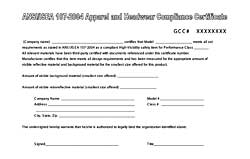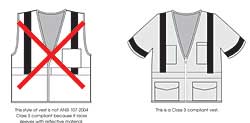Misinformation and the ANSI Standard
What you don't know can hurt you. Here's how to interpret the standard for maximum flagger safety and compliance.
- By Greg Hayward
- Aug 01, 2006
ON June 1 way back in 1999, a new standard for high-visibility safety apparel was established by ANSI/ISEA. This methodically researched and carefully written standard provides a concise, consistent, and authoritative guide for the design, performance, and use of high-visibility garments in the workplace. (More than 65 percent of all high-visibility garments are used in the road construction segment.)
The standard was revised Sept. 15, 2004, further refining the requirements. The current standard is ANSI/ISEA 107-2004.
Although the standards are researched, written, and sent out for extensive public comment, subjective interpretation of the requirements puts unnecessary risk on front-line workers. Without some guidance, there is too much room for interpretation, and therefore a greater likelihood for worker hazard.
What Does Compliance Mean?
There are three basic testing requirements to certify a garment as ANSI-compliant:
- Background material: The garment's material is put through a battery of tests that include brightness factors, colorfastness, and durability. The fabric always must be tested by a third party for compliance.
- Reflective material: A multitude of tests are conducted for retroreflectivity at different angles, in varied light and weather conditions, and for the durability of the material. This is also third-party tested.
- Design: A manufactured vest must meet or exceed several different design requirements, depending on class. An ANSI-compliant garment, for example, must have 360 degrees of horizontal reflective tape with no more than a 2-inch gap in the tape (at front or side closures). Look for an ANSI label that states the name of the standard, the class of the garment, and the level of reflective material (see below).

Third-party testing is not required for design compliance. However, a manufacturer can self-certify that its product has met all ANSI/ISEA requirements. Upon request, manufacturers are required to supply an ANSI/ISEA 107-2004 Apparel Compliance Certificate--a document signed by an authorized company representative. Always remember to ask for this certificate to ensure garment compliancy.
Levels of Performance
Garments in Classes 1, 2, and 3 are typically vests, vests with sleeves, shirts, jackets, and coveralls. Class E is for pants and shorts. The last revision to the standard also included a new product group for headwear.
Class 1 is the minimum amount of material required to differentiate the wearer of the garment from non-complex surroundings. There must be ample separation from the pedestrian worker and vehicle traffic, and the wearer must be in a position to give full and undivided attention to the approach of traffic. Class 1 candidates are usually workers directing drivers in parking service locations, collecting carts in parking lots, and those exposed to warehouse equipment traffic. Also included are sidewalk maintenance personnel and delivery vehicle drivers. In many cases, Class 2 vests are equal or less expensive than Class 1 garments because of market availability and low demand.
Class 2 provides superior visibility by covering the torso with a larger garment. It is beneficial during inclement weather and in complex backgrounds. Use a Class 2 garment when people are performing tasks that divert their attention from oncoming traffic and when work takes place in close proximity to traffic. Class 2 is beneficial for crossing guards, railway workers, roadway construction workers, accident site investigators, and so on.
Class 3 garments offer the greatest visibility in both complex backgrounds and when the wearer must perform a full range of body movements. Both the garment's backgrounds and its reflective materials are enhanced. Class 3 is for workers exposed to higher vehicle speeds and those with high task loads, making them conspicuous through the full range of body motion at a distance of 1,280 feet. Typical wearers are flagging crews, roadway construction crews, survey crews, utility workers, and emergency response personnel. In order to be Class 3, a vest must have sleeves (see below).

Feel the Need
The inclusion of vehicle speed in the standard is precisely where a lot of misinformation occurs: Most definitely, traffic speed alone should not dictate what a flagger or workers near traffic should wear, especially in situations where drivers are looking everywhere but the road. Workers with their back to oncoming traffic--just 3 or 4 feet away from moving vehicles--absolutely must be highly visible, therefore requiring a Class 3 garment. Conversely, workers in high-speed traffic situations could conceivably be 20 to 40 yards away from any moving vehicles. In addition, the nature of the workers' attentiveness and weather and light conditions factor into the decision. Risk assessment and garment selection should always be performed by a safety officer, risk engineer, or supervisor, taking not just vehicle speed but also a variety of specific conditions into consideration. Diligence and forethought are a must in every garment decision-making process.
MUTCD 2003
Most State DOTs and other city and county agencies comply with the Manual of Uniform Traffic Control Devices 2003 edition, published by the Federal Highway Administration. If your agency complies, then ANSI 107-1999 is required for specific personnel. Different rules apply for different states (Washington and Minnesota are two examples), and many states have adopted compliance into law.
For flaggers, Class 2 garments are required and Class 3 garments are recommended for nighttime work, even when the flagger station is illuminated. You can research more info at www.mutcd.fhwa.dot.gov. Follow the links to the MUTCD 2003 edition with Rev. 1, then navigate the quick links to Part 6, Chapter 6E. To purchase a copy of the ANSI_ISEA 107-2004 standard, call 703-528-2148.
Get Your Head in the Game
By this stage, you should be ANSI-compliant no matter what field you're working in. You also should be using risk assessment in addition to compliance standards to determine which garments are safest for your workers to wear.
In 2001, the high-visibility fabric industry responded to the "it's too hot" complaint by developing a breathable mesh fabric that was able to pass all ANSI/ISEA requirements. The cost issue was also addressed: An ANSI-compliant garment that cost $20 in 2000 may cost less than $10 today.
The standards are improving as well as the products, and in the end, worker safety is markedly better. And that's what it's all about.
This article appeared in the August 2006 issue of Occupational Health & Safety.
This article originally appeared in the August 2006 issue of Occupational Health & Safety.